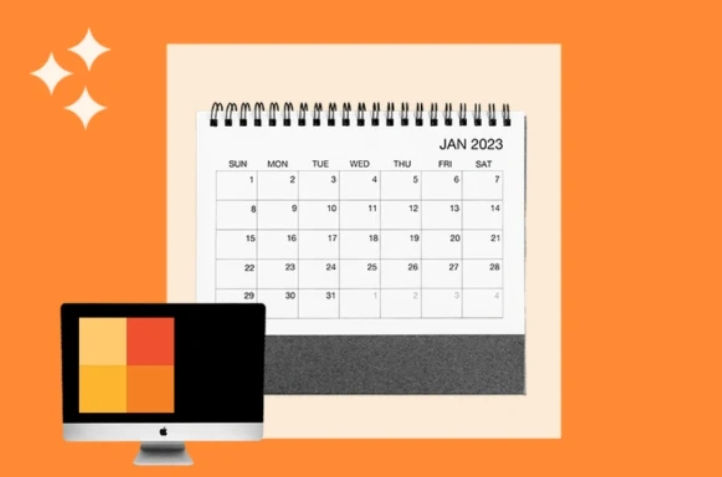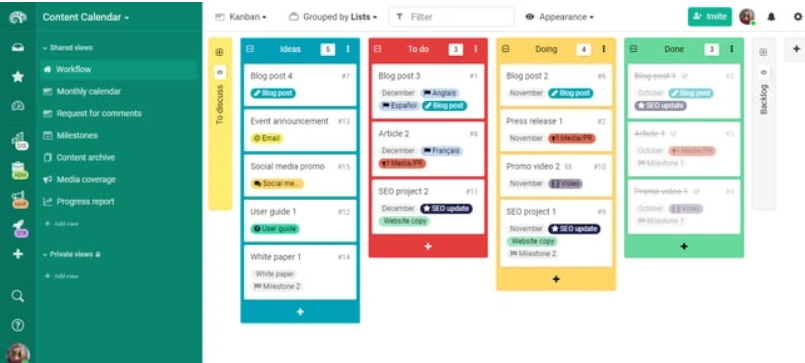Today’s part two in our look at editorial calendars and why they’re so indispensable. If you haven’t gotten a chance yet, we recommend giving the first part a read to learn more about how and why they can help you.
Otherwise, to the rest of it all!
The first steps in building an effective editorial calendar
Image Source: HubSpot.com
There are a handful of measures you can take that help create a solid foundation for your editorial approach. The following are steps we recommend to everyone:
- Select the right tools: There are many different calendar tools and softwares that you can use for an editorial calendar — these include spreadsheets, project management software, content management systems, or software dedicated specifically to editorial calendars. Heck, even just a big physical visualization can be extremely valuable here (although we wouldn’t typically suggest just relying on that). Here are some free options to get started.
- Define your content workflow: Outline the action items needed from start to finish for a clear visualization of the step-by-step process from ideation to publication, distribution, and promotion. If you’re working in a team — and most are — here is where you can assign responsibilities to different team members.
- Set clear objectives: This is just generally true of most endeavors, and here is no different; your editorial calendar should be aligned with your overall content strategy goals. Otherwise, you’re just doing more work for work’s sake and not getting as much out of it as possible. Each thing you publish should have a purpose in tying back to your overall objectives.
- Create a template: A standardized template makes it easier for team members to interpret, especially over the long term. You should include columns for titles, assigned authors, publication dates, distribution channels, keywords, and project status. You might discover other columns are useful, too.
- On that note, incorporate publication dates: Generally, you want to set these from the get-go. This way you’ll make sure what you’re publishing is evenly-spaced out, and you can incorporate topics that are relevant seasonally, with industry events, holidays, etc.
- Map out distribution channels: Lastly, this will help you determine where your work will be published and where it will be shared. This could include your blog, certain social media platforms, email newsletters, and other relevant channels.
Once you’ve established these, that brings us to…
Crafting a content plan
There are similar steps regarding the content plan itself once you’ve got the foundation for your calendar down. For ease of visualization, we’ll list them out similarly:
- Understand your audience: This should be a given, but in case it’s not, it’s at least the first thing we’ll mention! This includes defining both your audience’s most common demographics and psychographics, including interests, pain points, and preferences, which are all critical for you to understand in order to ensure the work you put out addresses their needs.
- Determine your content’s main categories and themes: The basics of these will likely be self-explanatory, but it’s still a good idea to explicitly identify these — this can help you ensure a range of topics within your umbrella that are diverse enough to capture (and recapture) readers’ attention, while still being about that which is useful and of interest to your target audience.
- Diversify content formats: Essentially, prepare to not put all your eggs in one basket. Sure, you don’t want to be spreading your resources too thin and do a bunch of things poorly (or inconsistently), but if you have the means it’s best to be producing work in multiple media. This could be blog posts, videos, infographics, podcasts, webinars, ebooks, and so on. Different formats cater more to different audiences and different processing and learning styles — give these a good consideration when deciding which you want to commit to.
- Do your keyword research and optimize for other SEO factors, too: We say this about so many things, but only because it’s true. Keyword research ahead of time helps you identify phrases and terms your audience are searching for so that you can help them find your work. Incorporate these terms — but do it naturally and don’t sacrifice quality in the process — to help improve how search engines rank you. But beyond your keywords and their incorporation in metadata as well, always prioritize writing for actual humans — who, by the way, can spot low-quality attempts at trying to “hack” SEO from a mile away.
- Create a promotion and engagement plan: You should establish ahead of time how you’ll promote your work; otherwise, you’re putting a lot of effort into creating something with very little payoff or readership. This could include social media teasers, email campaigns, and more. (We actually have more in-depth looks at blog promotion, check it out.)
- As important as anything: Stay consistent. Stick to your publication schedule as closely as possible, which gives audience members a general expectation of your timeline and a sense of when to return. If you can’t publish as frequently, it’s better to post, for example, once a month or six weeks than do weekly for a month and then not at all for the next four months.
Measuring and improving your performance
Image Source: HubSpot.com
Once you’ve got things flowing and your editorial calendar has you in a good rhythm for what you’re publishing, where you’re publishing it, and how often, it’s important to be cognizant of how this content is being received. Things that are performing well are great! But you’ll almost certainly find some pieces performing better or worse than others, and here you’ll want to figure out why so that you can improve in the future.
What step of the way is making certain pieces perform particularly good or otherwise? If positive, how can you adapt what you’re doing well there to other work? In negative outliers, what step of the process is going “wrong”?
Here are our pillars for both gaining insight on your content and improving upon what you learn:
Use analytics tools! If you’re not doing this, stop not doing this and start not not doing this. With how accessible and commonplace these are, there’s no reason for you to just be eyeballing things or making guesses, no matter how educated. Here you have Google Analytics — we’ve got more information on that here — social media insights tools, email marketing software, and content management systems to track and analyze whichever are your chosen key performance indicators, or KPIs.
Like we mentioned above, identify exceptionally high- and low-performing pieces. Find those which are doing super well and figure out why they’re performing so well — then, analyze how you can apply those factors to other pieces in the future. On the flip side, identify which are doing poorly, and follow that up with analysis on why they could have lower engagement and views.
Similarly, learn from your audience. There’s loads of insight to be gained from audience feedback, comments, and social media interaction. Here you can directly learn about what they especially appreciate or dislike.
And learn from your competitors. Just like there’s insights from your audience, there are insights to be had from your competitors. You’re not operating in a vacuum; study your competitors’ content strategies — from the content itself to the distribution and promotion thereof — and analyze what’s working for them.
You also want to, on occasion, test wholly new approaches. This means new topics that might be new (but still relevant) territory, new formats, new distribution methods, and so on. What resonates with your audience? What are some approaches that are more innovative that you may not have thought of yet? Then you can learn from there.
Lastly, conduct regular reviews of your strategy. Setting up regular intervals for reviewing your work helps ensure you don’t get complacent and miss out on loads of insights you could have on how to improve. During these times, you can zoom out and establish more macro-scale takeaways from the insights and analysis you’ve had so far, and from there revise your content strategy further.
Editorial calendars are such a helpful tool, and yet at the same time they’re so simple; essentially they just help you more clearly visualize the steps involved and in the process help you better conceptualize the project and sub-projects ahead. This will help not just streamline the process of creating and distributing published work, but will also be the foundation for consistency and improved performance over the long haul.






